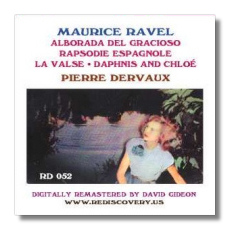
The Internet's Premier Classical Music Source
Related Links
- Ravel Reviews
- Latest Reviews
- More Reviews
-
By Composer
-
Collections
DVD & Blu-ray
Books
Concert Reviews
Articles/Interviews
Software
Audio
Search Amazon
Recommended Links
Site News
 CD Review
CD Review
Maurice Ravel

- Alborada del gracioso
- Rapsodie espagñole
- La valse
- Daphnis et Chloé: Suite #2
L'Orchestre des Concerts Colonne/Pierre Dervaux
ReDiscovery RD052 ADD 53:37
These recordings were made in 1960 for Command Classics. The Command team, headed by producer Enoch Light and engineer Robert Fine, took the label's 35mm film recorder to Paris and the Salle Wagram, and captured conductors Pierre Dervaux and André Vandernoot in French and Russian repertoire.
According to the LP release of Rapsodie espagñole (which I recently found for four dollars in a used record bin in Richmond, Virginia!), Dervaux was a percussionist in an orchestra actually conducted by Maurice Ravel. Dervaux was born in 1917, and Ravel died in 1937, so either Dervaux was a prodigy or someone's dates are wrong! At any rate, whether playing percussion under Ravel automatically places one in a position of being able to conduct his music authentically is debatable. Suffice it to say that Dervaux understands this music well, and conducts it in what I understand to be a typically French style: clear, precise, not overly emotional, and attentive to detail. Early in La valse, he exaggerates the string portamenti – a stomach-turning effect (and I mean that as a compliment!). Overall, the performance suggests that he buys into the notion that La valse is meant to scare and brutalize us. There is a chorus in Daphnis, although none is listed in ReDiscovery's notes. The two Spanish-themed works are given with color and panache, but overt sensuality is kept in check.
All of these recordings have been digitally remastered with loving care by David Gideon from reel tape masters. The sound, apart from being too bright for my tastes, and a little shallow, is very good. (Command used plenty of microphones during recording sessions.) There is little tape hiss.
ReDiscovery releases are available over the Internet at www.rediscovery.us; their service is fast and courteous. The asking price for most of their CD-Rs is only $15, and that includes shipping and handling. The releases look endearingly homemade - no labels on the CDRs apart from a handwritten catalogue number near the center hole, and rudimentary cover art and release notes. This time around, the cover "art" is particularly goofy – who is that woman, and where is that swimming hole? Too bad the Henri Michaux-on-mescaline-influenced print by Richard Claude Ziemann (on the original Rapsodie LP, anyway) couldn't be reproduced.
Copyright © 2004, Raymond Tuttle












